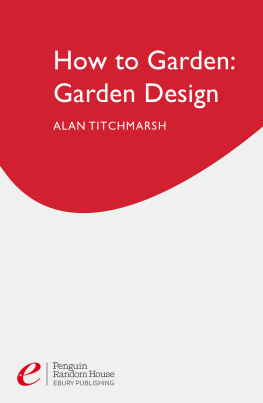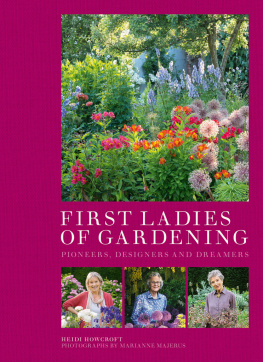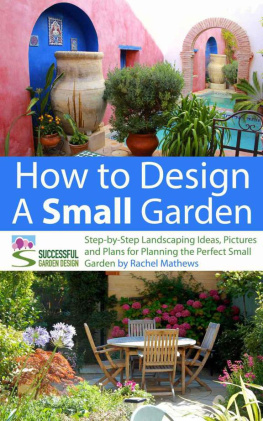Understanding Garden Design

Understanding Garden Design
The Complete Handbook for Aspiring Designers
VANESSA GARDNER NAGEL, APLD

For Michael, whose love and support encouraged this book to come to fruition.
Frontispiece: This stunning dry garden is only a portion of a much larger garden. The owners conceived a well-considered pattern of paths to visit and attend to the farthest reaches of the garden. Old Germantown Gardens, Bruce Wakefield and Jerry Grossnickle, owners.
All photographs are by Vanessa Gardner Nagel unless otherwise credited.
Copyright 2010 by Vanessa Gardner Nagel. All rights reserved.
Mention of trademark, proprietary product, or vendor does not constitute an endorsement, guarantee, or warranty of the product by the publisher or author and does not imply its approval to the exclusion of other products or vendors.
Published in 2010 by Timber Press, Inc.
The Haseltine Building | 2 The Quadrant |
133 S.W. Second Avenue, Suite 450 | 135 Salusbury Road |
Portland, Oregon 97204-3527 | London NW6 6RJ |
www.timberpress.com | www.timberpress.co.uk |
Text design by Susan Applegate
Printed in China
Library of Congress Cataloging-in-Publication Data
Nagel, Vanessa Gardner.
Understanding garden design: the complete handbook for aspiring designers/Vanessa Gardner Nagel.1st ed.
p. cm.
Includes bibliographical references and index.
ISBN: 978-0-88192-943-0
1. GardensDesign. I. Title.
SB 472.45. N 34 2010
712.2dc22 2009053692
A catalog record for this book is also available from the British Library.
Contents

Acknowledgments

It took many people to bring this book to life. My husband, Michael, is my mentor and motivational guru. My daughter, Wendy, put the idea of a book in my head, with the rest of my family behind me all the way. So many friends provided support, but especially Michael Peterson, Clark Jurgemeyer, and kindred garden spirits Bonnie Bruce, Laurel Young, and Lesley Cox. They provided additional time and insight in the form of willingness to read the books draft. My gardening friends, professional colleagues, and wonderful clients have provided immeasurable learning opportunities. Thank you to the staff at Timber Press, especially Tom Fischer, who allowed me to express my experiences and ideas as a book; and to Lorraine Anderson, who made this book comprehensible through her gift of editing. Special thanks to these contractors for providing their time and support: JP Stone Contractors; Dinsdale Landscape Contractors, Inc.; JSI Landscapes; Tryon Creek Landscape; McQuiggins Inc.; D & J Landscape Contractors; Winterbloom, Inc.; Drakes 7 Dees; Circadian Consulting & Design; Landscape East & West; Energy-Scapes, Inc.; and Landscape Design Associates of Westchester, Inc. My appreciation would be incomplete without a thank-you to Beverly Martin, who advised me to write; to Allan Mandell, who taught me to mind each corner in a photograph; and to my mother and grandfather, who taught me to love plants.
Trillium kurabayashi is a nice surprise in early spring. Authors garden.
Introduction

Whether you are a novice gardener, are launching a career as a landscape designer, or install gardens, understanding the detailed process of planning, designing, and implementing the installation of a garden is an invaluable tool. Landscape design is an astonishing blend of knowledge. From visualizing concepts to using design principles to setting a stone, you will test your visualization skills repeatedly. The better you understand the entire process, the better the outcome will be.
When I began practicing landscape design, it was after a twenty-two-year career in commercial interior design. I had a bachelors degree in interior design, but I returned to school to take classes in landscape design. What I discovered was an inadequate choice of reference books that tackle the entire process of landscape design. There are sources that address specific areas or topics. However, I could find no comprehensive resource useful to landscape design students, homeowners, and design-build contractors.
After I had been practicing landscape design for a time, my daughter called to ask for a book recommendation. She had been searching for a book that would help her get started with her garden. She said, Mom, they all start somewhere in the middle and added that the middle meant a discussion of basic design principles. She was looking for a book that truly started at the beginning. She recognized that something had to happen before thinking about things like form, texture, balance, and other design principles. After I enumerated several tasks that would help her begin the planning of her garden, she said, Mom, you need to write that book. Thus began my book-writing journey.
A series of zigzag raised beds along the south side of a house provides an attractive kitchen garden just outside the kitchen door. The arrangement not only provides additional planting space but also prevents the space from feeling like a bowling alley. Garden of Darcy Daniels. Photo by Darcy Daniels.
It was with my daughter in mind and my own experience as a landscape design student that I wrote this book. The book begins by answering the question, Why design? This question haunted me for most of my interior design career. Beyond my enjoyment of what I was doing, how did it benefit the people who used the space? I always hoped that my professional design organization would find a way to evaluate how design benefits people. Where were the measurements that defined the value of design?
A meeting at a high-tech firms offices to design their interior space revitalized my search. There I found a blue and gray environment that depressed me for the brief period I was there. What was this environment doing to the employees?
I began an evaluation of the benefits of color, and started to find answers in psychological journals and a couple of books about the psychology of color. This search predated the Internet, which meant it took considerably more time and effort to find resources than it does now. Learning about the value of color and its impact on employees helped me change a blue and gray organization into one that allowed an expanded use of color in the workplace.
How does landscape design benefit my clients? This continues to be an important question. I know that a layout that meets clients needs helps them function better. I hope it encourages their interaction with nature. I hope it renews their spirits and gives them a keen sense of being alive. I hope it helps them connect to their greater purpose and inner excellence. Whether a garden is an idyllic setting or rows of crops, it elementally connects us to nature and to our planet. When my hands are in the dirt, someone once suggested to me, that is where I will find wisdom. Is this a provable statement? Perhaps not yet, but it feels right to me as a lifelong, devoted gardener.
Next page








